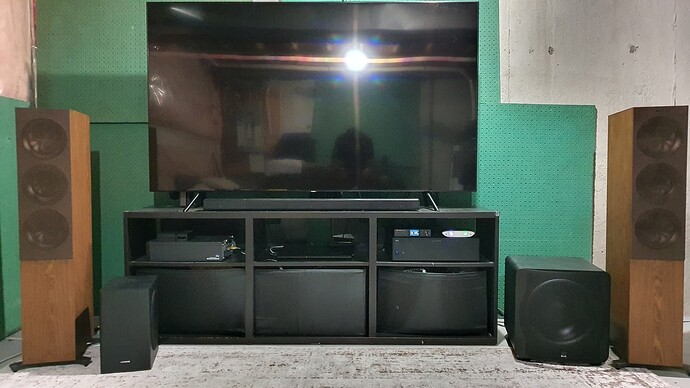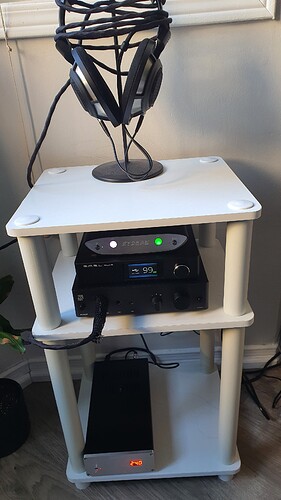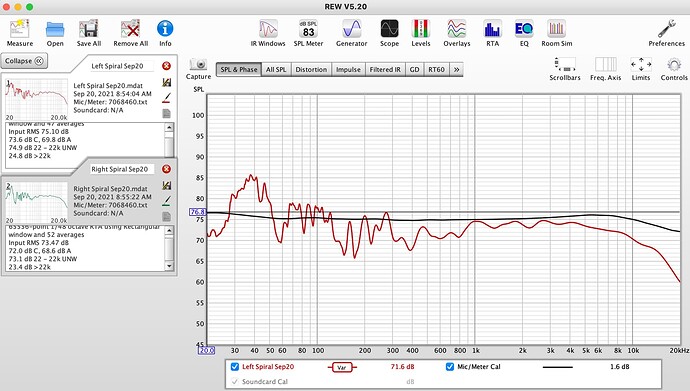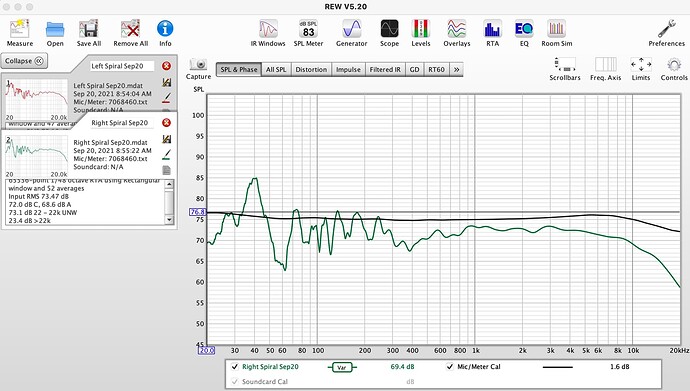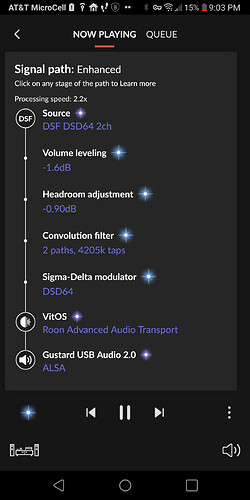Thanks will try to recheck and redo it and see if there’s a material difference
That’s a nice system. If you’re only using one sub, center placement is going to excite more room modes than moving the sub to an off-center position. I’d try sliding the SVS closer to the left or right speaker. Quarter wavelength at 80 Hz is still 3.5 ft, so you’re unlikely to aurally locate the position of the sub if you move it +/- 3.5 ft from the center-line of the room. But, doing so will almost certainly give you more even bass.
Otherwise, your uncorrected response looks quite good. Only minor issue that I see is the broad null between 40 and 70 Hz (perhaps check the phase of the sub or adjust listening position) and the broad peak between 400 and 800 Hz (can be adjusted with low Q filter).
Thanks @David_Snyder
I have obviously tried a lot since then and below I share the latest position that feel happy with. I have since changed the streamer from Node 2021 to the IFI Zen Stream and it has made a huuuge improvement in SQ. Also, I have changed the NuPrime amp to NAD C298 Purifi amplifier fed balanced from my SMSL SU-9 and I must say it sounds sublime. Btw, the Zen Stream was so good I got one for my headphones setup as well (also below).
As for room correction, I am following @OCA guide to the T using REW, FR and phase corrections
but for some reason the results I am getting is a little lifeless compared to native playback without room correction. I am going to experiment more off course. As for low FR if sub, I keep it to 50Hz cutoff as these KEF R7s have a very nice FR down low and I kinda like the sub to be not there unless it’s needed.
I don’t know but with my setup I am also observing that red book Tidal Connect is sounding more cleaner than Roon playback without any messing with the signal, I could be wrong but it’s liberating as Tidal app has come a long way and as if now it’s superior for streamer fanatics out there than Roon… especially compared to the Roon Mobile app which I don’t like (being a lifetime Roon subscriber doesn’t help  )
)
My current setups:
Dear Magnus, dear all,
I have done my room correction using REW as described in your first post. Everything works fine. After importing the zipped wave file and starting Roon I got a lot of distortion. Tried it several times and really do not know how to solve this annoying distortions
In addition I want to kindly ask how Roon knows the correct Left and Right channel
Hope I do not ask stupid questions. Would really appreciate your help! Please find my curve.
Audiophile Greetings
Not seeing a screenshot of your filter settings in REW, I would guess that you have filters with gain (positive dB values) and thus cause digital clipping.
If so, enable headroom management in Roon and tick the box for the clipping indicator, which will turn your signal path star red on clipping incidents.
When that happens, start entering ever more negative numbers into the headroom field until the respective snippet of music does not clip any more.
Or determine the maximum boost value of the filters generated with REW and enter that as a starting point…
Did you try a simple reboot of Roon? It might take care of itself! Simple to try!
Thx! Have done it and it works! Thx!
Thx for your advice!
Hello again
Magnus has given an excellent step-by-step tutorial about using REW software to build convolution filters for Roon.
He suggested several steps and settings. Is it possible to give some explanations why it is recommended this (but not other alternatives). I would really appreciate to learn more details in this techniques. Thx!
Basically I experimented and suggested what I found best and easiest to use. There are for example technical pros and cons for moving mic technique, but this guide is meant to be an (easy?) guide for DRC so I have kept it as non-technical as possible.
I also doubt there is one universal way that works best for everyone, so once you have something working from this guide I strongly suggest to experiment and try different ways (for example, compare moving mic to average of sweeps).
Hi Magnus, thx so much for your response. I really appreciate your guide and indeed, it is easy to build up the convolution filter. And I strongly believe that the moving mic technique is great.
Nevertheless I do not understand in the settings, why there are used a 96kHz sampling frequency, and different other settings like ‚rectangular‘. It is only my question to better understand the process of filter building. In summary, a really mighty software, but I do not understand how it works. Perhaps you know a link of a manual/tutorial to get more understanding of building up convolution filters.
Thx again for your great work!
Really really well worth the investment, wow what a difference in sound! I’ve watched the video on digital room correction from this source first – understanding a few basics (while impatiently waiting for the mic to arrive)
And well, I can only say that:
- My stereo imaging has improved significantly (no stereo phantom center anymore)
- The soundstage has improved significantly, instruments are placed much better
- No more muddled/dalayed bass, I have my office in a concrete box and that did terrible with the sound
Thanks @Magnus for your efforts! Happy camper here!
Hello! I apologize if my question has already been asked by someone. When using Convolution files, I have problems playing DSD. The sound quality is greatly degraded. Is it possible to use Covolution for DSD files?
Thank you in advance for your answer and help.
It’s not possible to do DSP on a DSD stream, so what Roon does (when needed) is to convert DSD to PCM, perform DSP on PCM, and then back to DSD.
Up-sampling to DSD works better though since then DSP is performed on PCM before the conversion to DSD.
Respectfully, some setups support convolution DSP to native DSD with no conversion to PCM. There’s some explanation here in the community about how this works, but I don’t have the reference handy.
Requires a lot of CPU, but it works and sounds great in my system.
Hmm, I don’t know the tech stuff deep enough to say for certain, but I think some sort of internal conversion is needed, and they seem to add the modulator again later on which confirms this.
Hi @Magnus - I finally found a post from @brian that explains this:
Have a look and let me know what you think.
I actually read that before, forgot it until now. I would guess that 64-bit wide DSD and PCM are rather similar, but the conversion becomes a little faster this way.
…a year later
Just rereading these guid posts, thank you @Magnus for your time and attention to helping skill up the community.
When generating and saving the IR filters, why not “Normalize to peak values”? Would this not produce a more detailed filter, without compromising on the selected measurement SPL?
